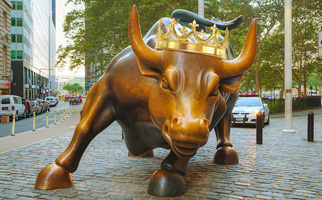
Today the stock market is being widely celebrated for having set a new record as the longest bull market in history. At 3,453 days old, it officially passes the previous record set by the bull that ran from October 1990 to March 2000.
Except that the new record carries a couple of asterisks (see below).
First though, it’s important to recognize that this doesn’t really matter either way, for a couple of reasons. First, and most importantly, bull markets don’t die of old age! "Typically, they die of fright," says veteran market strategist Sam Stovall, "And what they’re most afraid of is recession." With no signs of a recession on the horizon, there appears to be little risk of this bull market petering out simply because it’s old.
Which brings us to the second important point before delving into whether the current bull is really the longest in history. That is, any way you slice it, this bull market is old. The only question is whether it’s truly the oldest.
* #1: Can’t have it both ways
To understand why this isn’t a cut-and-dried case, we have to establish what parameters we’re using to define bull markets. The common definition of the start of a bull market is when a market advances at least 20% off a prior low. And the end of a bull market (i.e., a bear market) is commonly defined as a drop of -20% from a prior high. Seems simple enough.
The main problem with the "oldest bull market" argument is that there have been multiple market declines through the years that came up just short of 20%. And there’s a bit of cherry-picking going on in terms of which of these are counted as bear markets and which aren’t.
In order to count the current bull market as being uninterrupted since its start in March 2009, we have to not count the -19.39% drop in the S&P 500 that occurred between April-October 2011. No problem — it didn’t reach 20%, so it doesn’t count.
Ah, but wait! The reigning "longest bull market" that is allegedly being unseated is dated as having begun in October 1990. That start followed a drop of -19.92% between July-October of 1990. If we’re throwing out the -19.39% decline over 157 days in 2011, shouldn’t we also throw out the -19.92% decline over 87 days in 1990? If so, that legendary "1990s bull market" actually started in late 1987, meaning the current bull market is still about 3 years short of breaking the all-time record!
* #2: Is this still a bull market?
This seems like nit-picking after the market briefly set a new all-time high during yesterday’s session. But technically, the current bull market is "on probation" until it closes above its January 26 high. In other words, if the market were to decline from here into a bear market, the "current" bull market wouldn’t be current at all — it would be dated as having ended back in January. A minor point perhaps, but it would be ironic if this bull market was widely celebrated now for having become the longest on record, only to have that subsequently revised on the technicality that it actually ended several months earlier.
Market’s best six months is almost here!
Whether this is actually the longest bull market in history is less important than what the market’s prospects look like from here. On that front, the outlook looks very positive, at least for the short-term.
SMI’s longer-term concerns over the market’s valuation are well documented. Eventually, those valuations will matter and will weigh down the market’s returns over the next decade or so as regression to the mean kicks in. Investors absolutely have to keep this in mind as they plan and prepare for the future.
But those are longer-term concerns. Over the short-term, there’s considerable reason for optimism. And that’s largely due to one of the most historically reliable and powerful patterns we’re aware of: the election cycle.
Let’s back up. Lost in the enthusiasm over the "longest bull market record" and the market briefly touching a new all-time-high yesterday is the fact that stocks have been dead money since January. The market has spent the past seven months just trying to get back to where it stood in late-January. In fact, this has been the longest period of time the market has ever spent in so-called "correction" territory (a drop of 10%+ without reaching the 20% threshold that signifies a bear market) before reclaiming its prior high. While that sounds pretty bad, it needs to be considered against the backdrop that we know the six-month period leading up to the mid-term elections is traditionally the weakest stretch of the four-year election cycle. If this "treading water" since January has been this year’s version of that traditional market weakness, it’s actually been fairly mild.
What follows that traditional period of market weakness — the period sitting just ahead — is the best six-month period of the four-year election cycle! Ken Fisher notes that the 4th quarter of mid-term election years have been positive 87% of the time, as have 87% of the following (first) quarters. Those six months see stocks rise an average of +14%. There hasn’t been a negative third year of a president’s term (which would be 2019) since the start of World War II.
Before dismissing this pattern too quickly, Fisher offers a rather compelling reason as to why it has persisted decade after decade. His contention is that markets hate rising uncertainty and love falling uncertainty. The months leading up to the mid-term elections carry a high (and rising) degree of political uncertainty, as it often looks as if the party in power will lose seats and the political balance may shift, leading to unpredictable outcomes. Once the mid-term elections occur, all of that uncertainty goes away. (Fisher points out that in mid-term election years, the markets actually tend to start performing better in October because the uncertainty actually starts to fall before the elections themselves as individual races become clearer and a better expectation of what’s about to happen takes shape.)
And as a bonus (from the market’s point of view), the mid-term elections usually shift a degree of power from the president’s party to the opposition, leading to increased gridlock. The market’s love gridlock because nothing changes! That’s the whole uncertainty angle again — no changes equals minimal uncertainty.
I don’t know if Fisher’s explanation is ultimately correct, but it does make a lot of sense. And with virtually no signs of recession anywhere on the horizon, it’s reasonable to think the market may be poised to break out to new highs and run a bit higher yet into 2019. So while the celebration over the bull market’s age may be much ado about nothing, the conditions rapidly approaching this Fall may be worth getting excited about.







